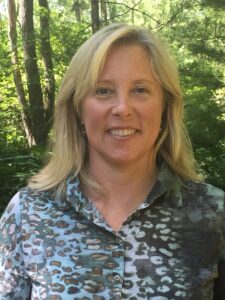What Nature Can Do for Your Brain (and Your Brain Can Do for Nature)
Susan Masino is the Paul E. Raether Distinguished Professor of Applied Science at Trinity College. She is a neuroscientist, and her research into adenosine, the ketogenic diet, and their links to treating seizures as well as other disorders is well-known. Masino’s parallel work looks at brain health and natural areas, especially our current or future old-growth forests. This work might be lesser known but is critically important to climate stabilization and human health.
How did you first become interested in and a proponent for wild areas and wild forests?
My Ph.D. is in biology, and I have always been interested in the natural world. About 20 years ago, I became a founding member and the spokesperson for Keep the Woods, an organization formed initially to protect a forest on top of our drinking water [in Simsbury, Connecticut]. It took 10 years! We had five town votes, many fundraisers, and applied for grants. Now it is a beloved area and on the Wildlands in New England map. During this project, I learned a lot. I realized how important natural areas are and why we need more. I started incorporating brain health and nature into my teaching and scholarship.
What is the connection between human brains and wild forest ecosystems?
There are reciprocal connections and some parallels. First, these are both incredibly dynamic and resilient systems, literally pinnacles of evolution. In the same way that we don’t even understand how one neuron works, and certainly not how a brain works, there are a lot of mysteries above and below ground and up in the canopy of old forests.
Second, wild forest ecosystems are good for our brains. Older forests are cooler and wetter and rated as more beautiful. There are direct health benefits like lowered blood pressure and countless studies that show links between time spent in nature and increases in creativity, divergent thinking, and problem-solving and decreases in depression and anxiety. There are great benefits for specific populations, like veterans and at-risk teens.
One benefit for all ages and abilities is the great healing power in experiencing awe: Nature is awe-inspiring. Awe also promotes fairness, compassion, reduced ego, increased cooperation, and all the things we need to work together to solve our most pressing problems.
One thing I talk about often is that these two complex systems—human brains and forest ecosystems—are the foundation for everything we need. We need brains from different disciplines working together on this common goal. Our complex brains, their creativity, and their ability to sense awe can work together on our best future.
Why are wild forest ecosystems so important?
I think of natural systems and the complex web of life as our common ecological lifeline. At the big-picture level, forests bring water across land to support life and stabilize the climate. Deciding what we do where and why with our forests—locally and globally—is a public health priority of the highest magnitude. We need some forests for resources, but natural forests are not optional. Wild forest ecosystems have evolved genetic knowledge that we don’t fully understand, and we ignore at our peril.
Water is foundational, but the short answer is the benefits are many. At the local level, people need a place they can count on. Forests managed for natural processes become “old growth,” a system with all ages and species that functions on incredibly long timelines. We can share these special areas across generations.
From my biomedical background, I know that forests are a major source of new medicines. Wild forest ecosystems are a reference condition for nature-based solutions. We are still evolving, and we need nature more than nature needs us. My concern is that when we are so focused on doing—anywhere and everywhere—we overlook the need for some areas for nature and can degrade or destroy it. Without more explicit protection, critical things like our headwaters, old-growth forests, critical habitats, and wildlife corridors remain at risk. It is urgent to rectify this gap in public policy.
In your recent work, you and a colleague at Tufts University coined the term proforestation. Can you describe what that is?
Proforestation—which, by the way, is not a new notion but just one that we’ve named—is a scientific term for letting some existing forests grow and recover and once again become old-growth forests. We realized there was no specific word for that, and it’s an important concept. Nature is not optional, and it evolved to respond to and recover from challenges. So proforestation is a stewardship practice that simply prioritizes natural processes in existing forests and gives them time and space to evolve and adapt. Proforestation doesn’t ban anything, including people. It’s for everyone and everything.
In some of your work, you mention Frederick Law Olmsted, the early father of landscape architecture. How does his work relate to what you’re promoting?
Frederick Law Olmsted understood that urbanization was wearing down our batteries, and nature could recharge them. When Olmsted was alive, there were a lot of health issues related to poor sanitation and toxins in the environment. He promoted sunlight, foliage, clean air, and getting away from the sights and sounds of the city. He wanted these wild areas available to everyone, to promote beauty, democracy, and health, particularly for those who didn’t have the money or time to go on vacation.
Olmsted’s vision was foundational to the Organic Act which created the National Park System in 1916. He knew that if special places were not placed in the public trust they would be destroyed by private interests. I am honored to be cohosting an expert speaker series this year titled “National Parks: Past, Present, and Future.”
The next talk is virtual at 7:00 p.m. on Wednesday, May 7 and it features public historian Laurence Cotton. His presentation is titled “Frederick Law Olmsted: The National Democracy of Parks”. You can register here.
